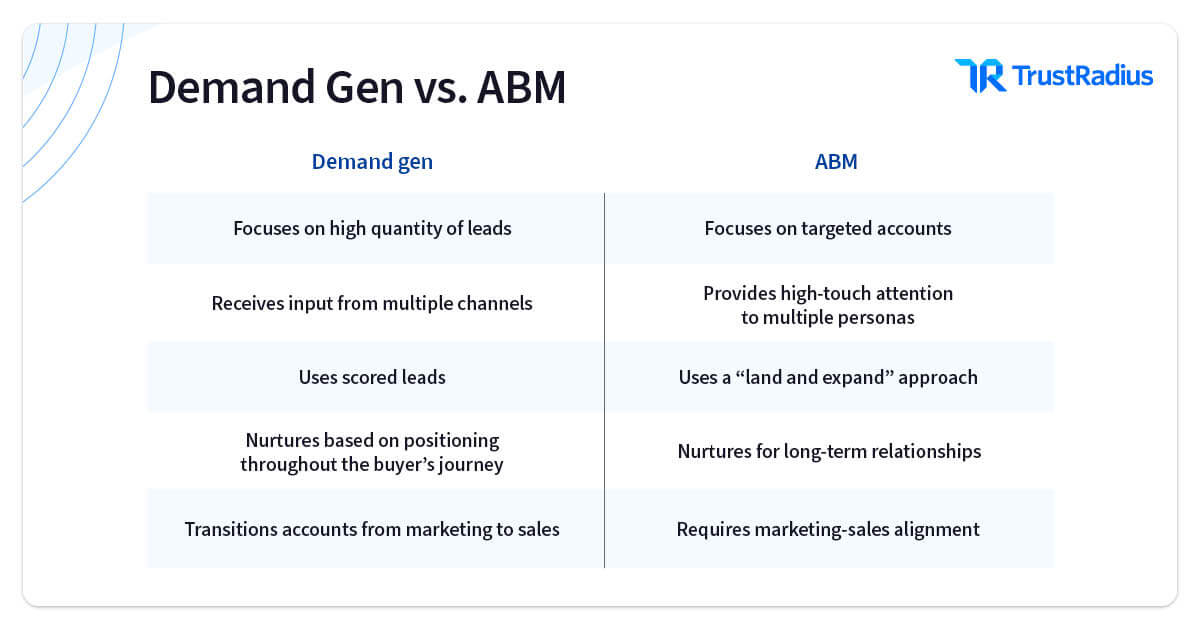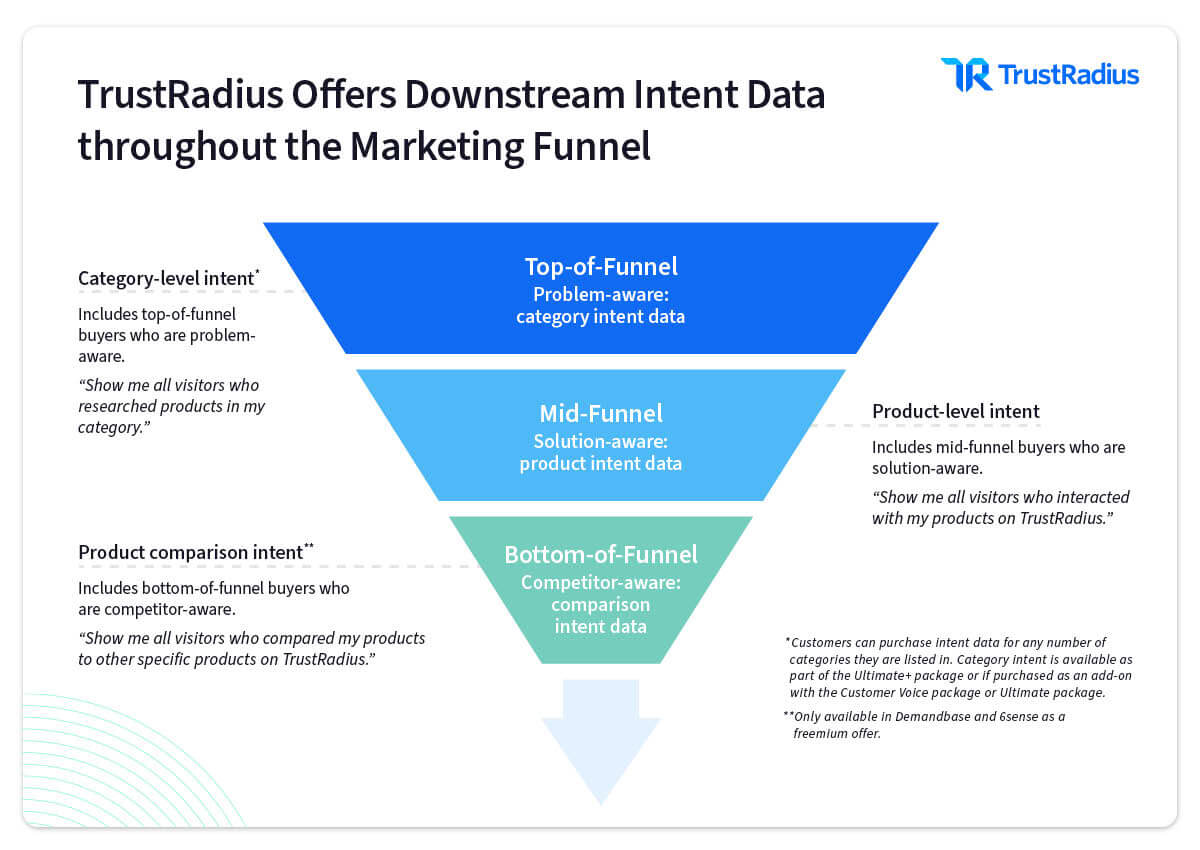ABM Trends: The Convergence of Demand Generation and Account-Based Marketing
Demand generation, or demand gen, and account-based marketing (ABM) have traditionally been thought of as two distinct strategies for B2B growth. That’s changing, as one of the key ABM trends for brands is uniting the two practices.
It’s a logical combination in many ways. Demand gen and ABM share a common goal of driving sales through a focused blend of inbound and outbound efforts. Research from Demand Gen Report shows that almost 60% of B2B marketers are already blending ABM and demand gen initiatives. This finding aligns with a Forrester SiriusDecisions survey that found over 50% of participating marketers’ “desired future state” was to be “‘broadly aligned’—sharing people, processes, and tools” on ABM and demand gen.
What’s driving this growing trend is the need to understand a more holistic view of the entire buyer’s journey. Also, the use of different types of intent is pushing organizations to bridge the gap between demand gen and ABM efforts. Especially with downstream intent data, brands can build customized messaging to follow and guide buyers down the funnel while continuing to nurture accounts to establish long-term relationships across an organization.
But while demand gen and ABM are still related strategies, there are key differences in messaging and go-to-market. Read on to learn more about the role of downstream intent data in bridging the divide between demand gen and ABM.
Demand gen vs. ABM
Demand gen focuses on finding ways to drive awareness and consideration of a company’s product and/or service. This includes capturing leads, nurturing to build pipeline, improving sales velocity throughout the buying cycle, and closing deals. In its ideal form, demand gen touches on the full life cycle of the customer experience and can be both broad and narrow in its initial reach.
ABM focuses on specific accounts that are recognized as high-value prospects or customers with high growth potential. While demand gen can initially take a broader approach to attracting leads, eventually narrowing down engaged marketing-qualified leads, ABM always starts with a much smaller list in order to have a very high-touch, targeted approach.
In this sense, ABM can serve as a specific stage of an overall demand gen strategy, and brands aren’t forced to choose between the two. The most successful B2B marketers include both as a part of their overall strategy.

ABM is certainly on the rise. Data from HubSpot shows that 70% of marketers are using it—15% more than in 2020. According to ITSMA and the ABM Leadership Alliance data, 76% of B2B marketers say that ABM’s ROI outperforms other marketing activities.
That said, ABM can be limiting for organizations that are targeting small to midsize businesses where more volume is key. ABM is about quality over quantity, so it’s crucial to use all available data to ensure efforts are targeted at the most valuable accounts.
It’s also important not to treat all leads as “account-based,” which can cause more harm than good. This assumption doesn’t consider the unique stages of the funnel and inhibits customized messaging. Demand gen and ABM strategies play an important role in building a pipeline and driving revenue, but instead of using them exclusively, brands can take a blended approach to continually building demand while monitoring for high-value accounts to target in a hyper-personalized way.
Aligning sales and marketing through converging strategies
Sales and marketing teams must be aligned to fully realize the benefits of a blended approach. ABM depends on demand gen activities to fill the top of the funnel, and shared data sets can strengthen efforts across all stages. This shared data helps teams jointly identify and detail accounts while creating a unified experience for the consumer.
Downstream intent data is often the ideal connection. Intent data can be based on behavior, serving as a bridge between the broader reach of demand gen and the bottom-funnel relationships of ABM. This behavioral data can be paired with data sets for demand gen and ABM teams to draw a larger picture of the buyer funnel and create an experience tailored to the stage of each prospect.
Intent data is considered downstream when it consists of quality intent signals representative of people who are researching you or your competitors’ products, and therefore, likely to be in-market to make a purchase and soon. Bringing actionable, ready-to-convert buyers to sales teams will speed up the sales cycle and improve close rates. The audiences built from this data should be used immediately, since they’re actually in-market buyers researching your product, which makes aligning sales and marketing teams a smooth process. Sales teams naturally view marketing efforts as valuable because they’re providing buyers who convert. At the same time, marketing teams see sales teams as successful peers who are efficiently engaging in-market accounts.
Aligning sales, marketing, and management is the best way for brands to combine the two approaches into a tailored strategy. This alignment starts with marketing and sales leaders creating direction for an ABM and demand gen plan, then distributing it throughout the organization.
Marketers should also consider business development representatives when creating the strategy, as they can serve as a bridge between marketing and sales while playing an integral role in the sales process. Another consideration is creating an incentive program that aligns directly with the strategy. Additional incentives for salespeople who close highly valuable ABM accounts, for example, could include monetary or celebratory motivation.
When we met with Erin Christopher of Totango, she explained that while it’s important to meet customers where they are in the buyer’s journey, it’s also important not to exhaust sales teams. As brands focus on quality leads, they need to identify high-intent customers. Downstream intent data provides these in-market customers and can help marketing and sales teams create unique segments to target throughout the buying funnel, thus improving demand gen and ABM campaigns alike.
Using intent data intelligently
Downstream intent data can play a vital role in developing a demand gen and ABM strategy, as it provides insights for prospective customers throughout the buying funnel. For example, as the only downstream intent data source, TrustRadius, a heavily used research tool, identifies potential in-market buyers for a product or a brand’s competitors.
Marketing teams can use third-party intent data to build campaigns with informative messaging for prospects near the top of the marketing funnel, while accounts showing lower-funnel signals can be identified for ABM campaigns. By tailoring messaging to meet the customer where they are in their journey, brands can build a more positive customer experience and take steps to nurture the relationship.
As prospects enter the funnel, awareness campaigns can begin to inform them about a problem they may have, provide potential solutions, and guide them further down the funnel. For those who are already showing strong signals of intent, like researching your product on a review site, lower-funnel activities and ABM can help close the sale faster.

Combining ABM and demand gen without martech bloat
A growing number of brands are combining demand gen and ABM efforts with success. By aligning teams with the most complete image of an ideal customer journey, organizations can develop more relevant and effective campaigns without adding to tech stack bloat.
Realizing innovation in ABM trends requires brands to converge ABM and demand gen to deliver personalized experiences for the accounts that matter most. ABM is great for directly reaching an ideal customer, and demand gen is critical for growing the volume of qualified buyers. Meanwhile, additional demand gen efforts should focus on educating and engaging with additional ideal customer profile targets to continue to nurture buyers along their journey.
Learn more about how to use downstream intent data in your ABM platform. If you’re not sure where to start, contact us to learn more.






